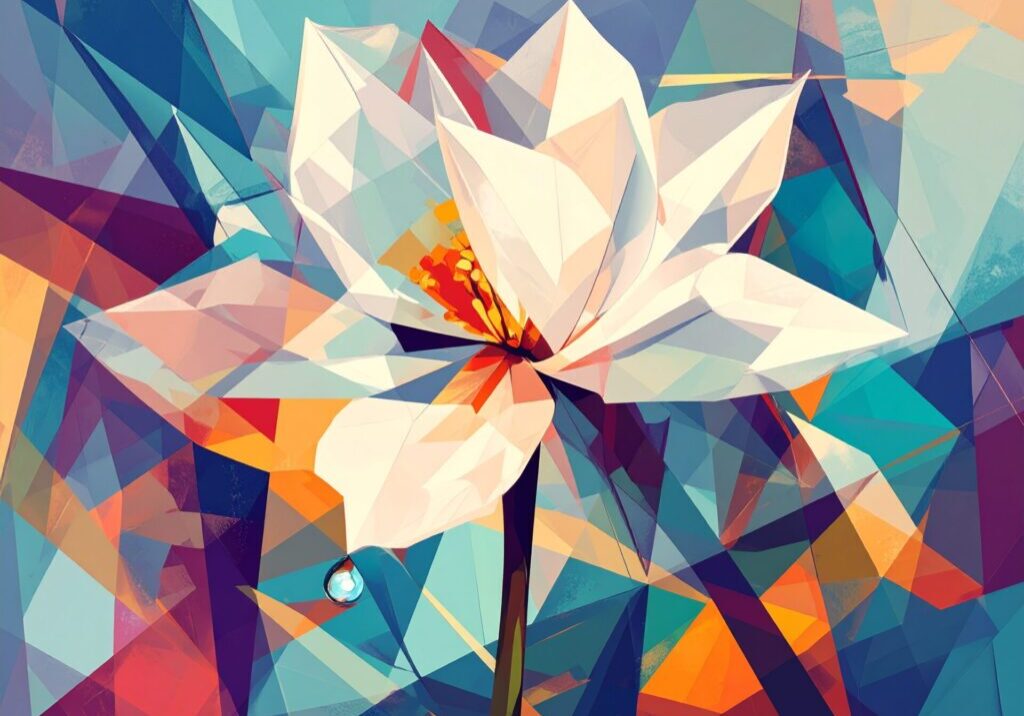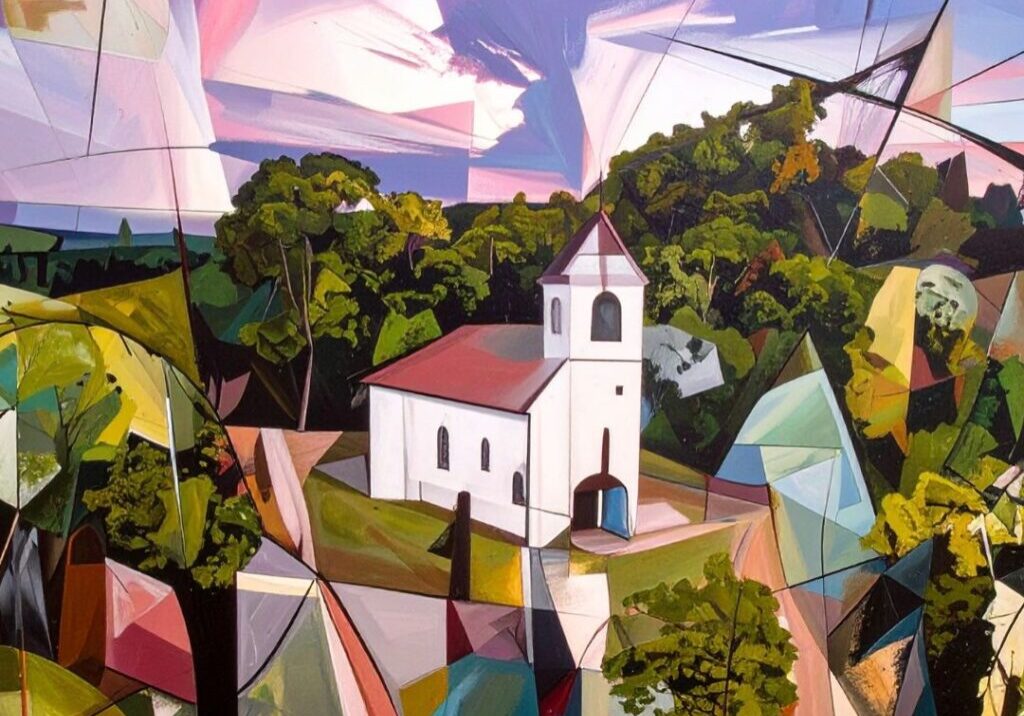Seeing with Two Pairs of Eyes
“Our life is a faint tracing on the surface of mystery, like the idle, curved tunnels of leaf miners on the face of a leaf,” writes Annie Dillard.[1] This simple but eloquent reflection is grounded in empirical knowledge of a particular phenomenon and couched in the language of place, yet also speaks to the soul, and in doing so, brings our attention to the connection between them, and to the integral nature of science and religion. Our encounters with creation draw us into larger questions of the meaning of life; into the realm of religion
In Pilgrim at Tinker Creek Dillard experiences Tinker and Carvin’s creeks as “an active mystery, fresh every minute. Theirs is the mystery of the continuous creation and all that providence implies: the uncertainty of vision, the horror of the fixed, the dissolution of the present, the intricacy of beauty, the pressure of fecundity, the elusiveness of the free, and the flawed nature of perfection.”[2] Here Dillard reads her own life into the text of the water, moving from the exterior to the interior world—into deeper self-reflection. Dillard continues, “Today I sit on dry grass at the end of the island by the slower side of the creek. I’m drawn to this spot. I come to it as to an oracle; I return to it as a man years later will seek out the battlefield where he lost a leg or an arm.”[3] Her words point to the particularity of place as well as the idea of emergence, as the flowing water reveals new revelations and helps us to perceive a connection between place or habitat and evolution.
In Sentient, How Animals Illuminate the Wonder of Our Human Senses, Jackie Higgins reflects upon how sentient beings offer a fresh perspective on “how we sense, even make sense, of the world and on what it means to be human.”[4] Although we tend to think in terms of 5 senses, and perhaps a 6th sense that has to do with intuition, neurobiologist Colin Blakemore reports that humans have up to 33 senses that enable us to interact with the places we inhabit in rich and varied ways.[5] In telling the story of a deep-sea expedition, Higgins informs us that “the ocean absorbs colored lights at different depths, according to their wavelength.”[6] Each layer has different properties of light and color. As one goes deeper, the spectrum of colors diminishes and creatures must transition from photopic to scotopic vision (derived from the Greek skotos, which means “dark” and opia, which means “vision”), or night vision.[7] Of all vertebrates, deep-sea fish have the best dark vision, as sight is the most important sense for deep-sea fish.[8] Large pupils, telescopic eyes, tapeta[9], and translucent heads are among the many traits that enable dark vision. [10] This phenomenon underscores the role of habitat in evolution.
In exploring the topic of dark vision Higgins introduces us to the four-eyed spookfish Dolichopteryx longipes , or “Doli” for short. Upon examining Doli’s eyes in the laboratory, Jochen Wagner, a professor of anatomy at TübingenUniversity, discovered, “The secondary eyes were clearly joined to the main eyes; Strictly speaking, the four eyes were two. Sectioning showed that each eye consists of two parts separated by a dividing septum,” explained Wagner. There is the main, cylindrical, tubular eye that points upward and a smaller ovoid growth from its side, a diverticulum, less than half the size, that points downward.”[11] When he examined the two sets of optics he found that the lower pseudo-eye did not have a lens. After further probing he discovered that the lower eye could refract light. It was a mirror, which was the last thing he expected to find! In nearly five million years of vertebrate evolution, including those living and dead, Doli is the only known vertebrate to use a mirror to produce an image.[12]
Doli’s eyes formed over millions of year in relation to the depths of the ocean. Higgins explains:
At 700 meters (2,300 feet), 100 meters (328 feet) beneath the point at which the light ran out the researchers, the black ocean is scattered with sparse pinpricks of bioluminescence that burn bright, then fade like distant, dim stars. A translucent and slender spookfish glides through the void, still but for a gentle, propulsive ripple through its winglike fins. It’s upward dash pointing eyes, with large pupils and tapeta, collect the scarce solar photons that penetrated these depths. It’s downward-pointing, mirrored pseudo-eyes gather photons from below: perhaps from the sun bouncing off a neighbor, perhaps from another’s bioluminescent signal. The two sets of optics radically expand the spookfish’s light-capturing horizons, maximizing the number of photons that reach its four retinas, bestowing sight. The spookfish can also shed light on us.[13]
The discovery of the four-eyed spookfish led to experiments on dark vision in humans and found that “…we have astonishing potential for vision in the darkest of places.”[14] What if humans were able to see with two sets of eyes – empirical and reflective, science and religion – and they were tethered together? What if the mirror of our downward gaze enabled us to see the immanent presence of Christ here and now, down below, rather than ‘up there’ and later? The Good News is that we can! Like Clare of Assisi, we may become “mirror mystics,”[15] with our second set of eyes positioned to capture the light and image of Christ reflected in the darkest places.
In Clare of Assisi: A Heart full of Love, Ilia Delio tells us that, in her letters to St. Agnes of Prague, Clare describes the crucified Christ as a mirror, and “in gazing upon this mirror we see a true reflection of ourselves—our image. Christ reflects back to us what we are to be in our lives.”[16] Only in the mirror of the cross, Clare indicates, do we truly see who we are and what we are called to be by becoming transformed into the image of Christ, for “to gaze is not simply to see. Rather to gaze is to be drawn into the object which one sees” and reside there.[17] Delio continues, “The gaze on the crucified Christ is an embrace of the heart, a desire to allow the otherness of God’s love into our lives. …The image of Christ that each of us is created to be is the way God’s presence is renewed in the world. Each of us is meant to be a mirror reflecting the face of the eternal God.”[18] Thus, “to look into the mirror of the cross is to realize that we are called to be images of God, and to be images of God we are called into relationships of love.”[19]
The town of Assisi, on the western slope of Mount Subasio, in the hilly Umbria region of Italy, shaped Clare’s exterior and interior worlds. In the Divine Comedy, Dante Alighieri refers to Assisi as the birthplace of the Sun. It is here that the light of Christ was born in Clare’s heart. Enabled by mirror vision, she was able to find and reflect the light of Christ in her time and in ours. Clare uses the language of place to instruct Agnes to “place your soul in the brilliance of glory! Place your heart in the figure of the divine substance! And transform your entire being into the image of the Godhead Itself through contemplation.”[20]
One need not live in Assisi to have mirror vision. We can be “mirror mystics” in the places we inhabit. Evolution has, in fact, given us mirror eyes to see the numinous in the places we inhabit; to see and reflect the light of Christ. Delio emphasizes that one must be relational in order to be in image of God.[21] This relationality, I propose, can be found in our relationships with each other as well as the places we inhabit; it is in our empirical knowing and our religious experience, as well as the tether between the two. I look out my third-floor bedroom window and see my own reflection in the sky, as the windowpane becomes a mirror as well as a portal to the outside. I am reminded to see like Doli; and in doing so, grow to recognize and reflect Christ in all things, and thereby participate in the transformation and Christification of the world. Although, as Dillard writes, our life is but “a faint tracing on the surface of mystery,”[22] take heart, as there are many of us, in relationship, using our four-eyed vision to illuminate tunnels, stories and lives that weave and intermingle, becoming the light of Christ in the darkest of places.
Reference Notes:
[1] Annie Dillard, “Pilgrim at Tinker Creek,” The Annie Dillard Reader. (New York: HarperCollins, 1974, 1994) 287.
[2] Annie Dillard, “Pilgrim at Tinker Creek,” 282.
[3] Annie Dillard, “Pilgrim at Tinker Creek,” 284.
[4] Jackie Higgins, Sentient, How Animals Illuminate the Wonder of Our Human Senses, (New York: Simon & Schuster, 2021), x.
[5] Jackie Higgins, Sentient, xi.
[6] Jackie Higgins, Sentient, 25.
[7] Jackie Higgins, Sentient, 26.
[8] Jackie Higgins, Sentient, 27.
[9] Tapeta is “a covering layer of cells behind the retina of the eye.” (https://www.collinsdictionary.com/us/dictionary/english/tapeta_
[10] Jackie Higgins, Sentient, 28.
[11] Jackie Higgins, Sentient, 30.
[12] Jackie Higgins, Sentient, 31.
[13] Ibid.
[14] Jackie Higgins, Sentient, 40.
[15] Ilia Delio, Clare of Assisi: A Heart full of Love. (Cincinnati: St. Anthony Messenger Press, 2007), 37.
[16] Ilia Delio, Clare of Assisi, 38.
[17] Ilia Delio, Clare of Assisi, 39.
[18] Ilia Delio, Clare of Assisi, 44.
[19] Ibid.
[20] Ilia Delio, Clare of Assisi, 39.
[21] Ibid.
[22] Annie Dillard, “Pilgrim at Tinker Creek,” 287.
 View print-friendly version
View print-friendly version
7 Comments
Related Posts

Mission for an Evolutionary Christianity
We are living through tumultuous times. Political polarization intensifies, violence against vulnerable populations escalates, and the foundational principles of human dignity face erosion. For many, the cognitive dissonance between professed…


Over 20 years ago, I lost all hearing in one of my ears. At times it seems that one ear is for outward surroundings while the other is for listening for the divine. This is more so when I am “treading water,” or allowing myself to float. When I grip the controls, I have trouble hearing either side at times.
Kay, thanks for taking the time to write such a thoughtful response.
I fully concur with the idea of reintegrating the imagination with reason, healing the “tragic fracture in our ways of knowing.” Malcolm Guite’s words here remind me of Wendell Berry, who likens the separation of the soul from the body and from the world to “a fracture that runs through the mentality of institutionalized religion like a geologic fault…a flaw in the mind that runs inevitably into the earth…” (The Unsettling of America: Culture and Agriculture, p. 108).
And I love what you write about Jesus teaching from a place of integrated knowing and the idea that the meaning will vary according to our habitat. Those are excellent insights, and I’m right there with you in terms of the “Ministry of Knowing.” Thank you for these wonderful words!
Emily, your musings intensify my growing conviction that until the sacred and secular are reunited into One our ability to mirror Christ has limitations. The Western church’s separation of science and religion, the Scientific Revolution, and our increasing emphasis on all things “tech” have only widened the manufactured gulf between sacred and secular.
Malcolm Guite in his 2021 book, Lifting the Veil Imagination and the Kingdom of God, states, “I want to make the case for a recovery and reintegration of the imagination together with the reason as modes of knowing ” (p16). He goes on to say that the life of Jesus, especially the incarnation, death and resurrection of Jesus all show that Christ came …” to heal the tragic fracture in our ways of knowing ” (ibid).
Knowing is seeing. Knowing provides meaning from symbols and we are and have always been symbolic “knowers”. Fire means warmth, safety, comfort. Our country’s flag brings known rituals and deep, deep feelings. Icons of our diverse religions elicit ancient ceremonies and sentiments deeply rooted within our psyche. The artificial forcing of religion into a completely rational and logical state separates us from complete knowing.
Knowing is not a ” left brain” operation. The brain is 1 brain, so just as the doli have 4eyes seeing as 2, we have a brain with 2sides integrated into one ( and connected to the heart).
Jesus taught from a place of integrated knowing. Parables and stories require us to extract meaning to arrive at understanding. The meaning will vary depending on “habitat”. Our places of life.
Seeing requires complete knowing. The reintegration of sacred and secular, religion and science calls for those with ” eyes to see and ears to hear” to be active in the Ministry of Knowing.
Joe, this is a fascinating response! I am reminded of Ilia, who often speaks of humans as being between the animals and the angels. I look forward to reading your book, once I get some other things off my plate.
Teilhard’s ‘divine milieu’ is an enveloping hierarchy of Light, a universal ocean of consciousness teeming with life, with capacity to live, move, see, and/or sense by it, based on the evolutionary complexity of each. Simplified, the highest order are CELESTIALS (heavenly hosts) or angels, each with “X-ray” vision to see and visually integrate in the 5-D to 10-D bandwidth frequency range and beyond. They’re the “seven eyed,” or “many eyed” ones (Enoch 20:1, Rev. 5:6), interbeing creatures that traverse the entire spectrum of light, seeing all things from the inside out, visually integrating all angles simultaneously. At the bottom are the TERRESTRIALS, primates, mammals (including humans), birds, and other invertebrates with front-facing eyes, binocular (stereoscopic) vision, and brain able to integrate two images coming from each eye into one 3-D visual experience. In the middle are the TELESTIALS (or “tweeners”), spiritually awakened terrestrials, reconciled expressions (off-spring) of a celestial-terrestrial marriage, and the trysting place of each. The former inhabits the latter forming a more complex (incarnational) expression of Itself in human form. Here, brain and consciousness are transparent to the transcendent along extrasensory lines, able to integrate 3-D and 4-D vision to see and value the divine image in all things in a manner lower than angels, but higher than terrestrials. Note: at all 3 levels and their variants, vision pivots on the integrated capacity to see as One from multiple angles, according to species and complexity.
John, your one line response is rich and poignant. Would you care to say more?
Yes , the habitat of mystery where ego gives way to humility?